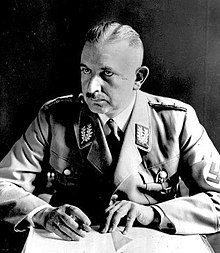Reich office for educational films

The Reich Office for Educational Films ( RfdU ), which was renamed the Reich Institute for Film and Image in Science and Education ( RWU ) in 1940 , was a central office for the production of educational films and an instrument for bringing German schools and training systems into line during the National Socialist German Reich based in Berlin .
The Reich Office for Educational Films was founded on June 26, 1934 by the Minister of Education, Bernhard Rust, on the initiative of former Lieutenant Egon von Werner . He also became the first managing director of the Reichsstelle. Kurt Gauger , Erich Daunert and Walther Günther became department heads . In 1936 Kurt Gauger advanced to the position of managing director of the Reichsstelle, who, under von Werner, headed the university department in the Reichsstelle. In 1941 Gauger was promoted to director of the Reich Office.
history
By 1944, the facility had produced an estimated 900 films; Over 270 of these were intended for schools, the rest for research and teaching purposes at universities. In total, more than half a million film copies were delivered. It is not clear to what extent these films were actually used.
The Reichsstelle for the educational film also served as a loan point for educational media such as films and photographs as well as for projection devices. In 1943 the establishment included 36 regional picture offices and 1,243 district picture offices, also in the occupied territories.
She was the editor of a media pedagogical series and from 1935 to 1943 also the magazine “Film und Bild in Wissenschaft, Erziehungs und Volksbildung”.
On February 6, 1935, a “University Department” was created within the Reich Office for Educational Films, which in 1936 took over the holdings of the “German Society for Scientific Films” (DEGEWI). On January 1, 1940, the "Department for Technical and Scientific Research Films" was removed and relocated to Groß-Cammin (Mark Brandenburg) in August 1943. In April 1945 the department was transferred to Höckelheim near Göttingen . From it later (1956) the Institute for Scientific Film (IWF) emerged.
In December 1945, immediately after the inventory was confiscated by US soldiers, the Institute for Film and Image in Science and Education (FWU) was founded as the successor organization. The subdivision into circle picture areas was retained.
See also
literature
- Adolf Reichwein : Film in the country school. From looking to creating . Kohlhammer, Stuttgart et al. 1938, ( series of publications of the Reichsstelle for the educational film 10, ZDB -ID 1069205-8 ), (new edition in: Wolfgang Klafki et al. (Ed.): Schaffendes Schulvolk. Die Tiefenseer Schulschriften . Beltz, Weinheim et al. 1993, ISBN 3 -407-34063-X ).
- Michael Kühn: Educational film in National Socialism. The work of the Reich Office for Educational Film / Reich Institute for Film and Image in Science and Education . Septem Artes, Mammendorf / Obb. 1998, ISBN 3-929168-21-9 , (at the same time.. Munich, Univ Bundeswehr, Diss, 1997) (fact-rich but something undistanzierte work) .
- Malte Ewert: The Reich Institute for Film and Image in Science and Education. (1934-1945) . Publishing house Dr. Kovač, Hamburg 1998, ISBN 3-86064-681-8 , ( publications on cultural studies 15).
- Malte Ewert (Ed.): New documents on the history of the school film movement in Germany . Volume 2: The circulars of the Reich Office for Educational Films (RfdU) and later Reich Institute for Film and Image in Science and Education (RWU) . 2 parts. Publishing house Dr. Kovač, Hamburg 2003, ISBN 3-8300-1208-X , ( Studies on Contemporary History 35), review .
Web links
- In excerpts digitally available collection produced a number of the RWU and displaced scientific films and related publications in Virtual Laboratory of the Max Planck Institute for the History of Science
- Malte Ewert (ed.): New documents on the history of the school film movement in Germany II ( Memento from February 12, 2013 in the web archive archive.today ) (book review)
- Ulf Schmidt, The medical research film in the "Third Reich"
- www.fwu.de , website of the successor organization
Individual evidence
- ^ Harro Segeberg: Medial mobilization . Wilhelm Fink Verlag, 2004, ISBN 978-3-7705-3863-8 , p. 73 ( google.de [accessed on February 23, 2020]).
- ↑ a b Harro Segeberg: Medial mobilization . Wilhelm Fink Verlag, 2004, ISBN 978-3-7705-3863-8 , p. 77 ( google.de [accessed on February 23, 2020]).
- ↑ Newspaper Studies . Duncker & Humblot, 1935, pp. 192 ( google.de [accessed on February 23, 2020]).